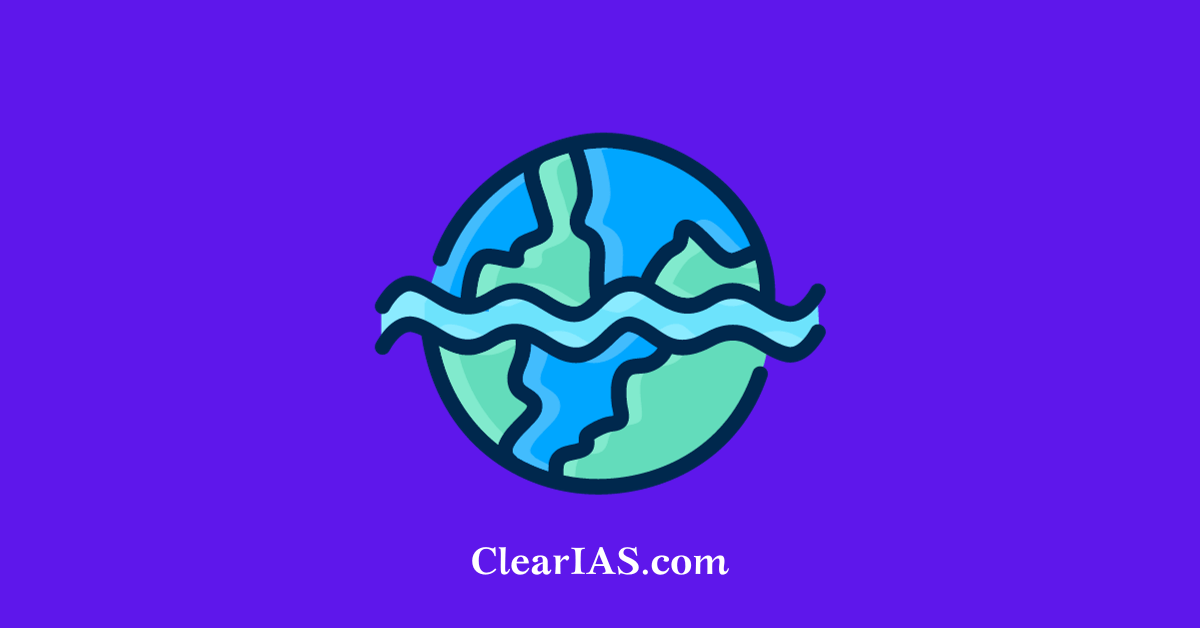 What are Ocean Currents? Which are the major Ocean Currents? How to learn the names of various Ocean Currents? Read to know more.
What are Ocean Currents? Which are the major Ocean Currents? How to learn the names of various Ocean Currents? Read to know more.
In our geography notes on the hydrosphere, we have seen the major movements of the ocean water. They are – waves, tides and ocean currents.
Having covered the fundamentals, we shall see in this post, a super-fast way to learn the details of ocean currents.
Names, direction, nature….and what not!
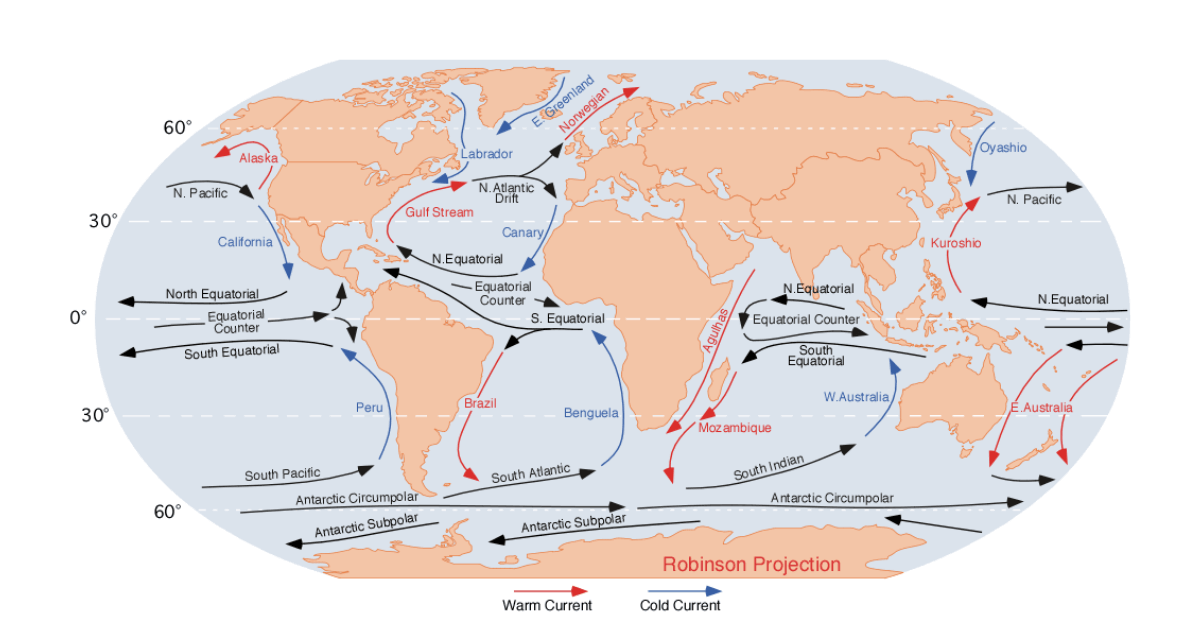
Well, you might have heard so many names like Kuroshio current, Oyashio current, Peru current etc. Is Kuroshio a cold current or warm current? Where is its location?
It’s not easy to remember all the names, locations and types (warm or cold) of ocean currents – without the right guidance. UPSC often ask questions in Prelims and Mains from the topic of ocean currents. So, what is the short-cut approach to learning fast? Well, wait and see.
How can you learn the names of ocean currents, faster?
ClearIAS has prepared a mind map from the above map. We have shown the major current systems in the three oceans – Atlantic ocean, Indian Ocean and Pacific ocean – from left to right. Continents are represented in ‘Green’, warm ocean currents in ‘Red’, and cold ocean currents in ‘Blue’. Hope it’s easy now!
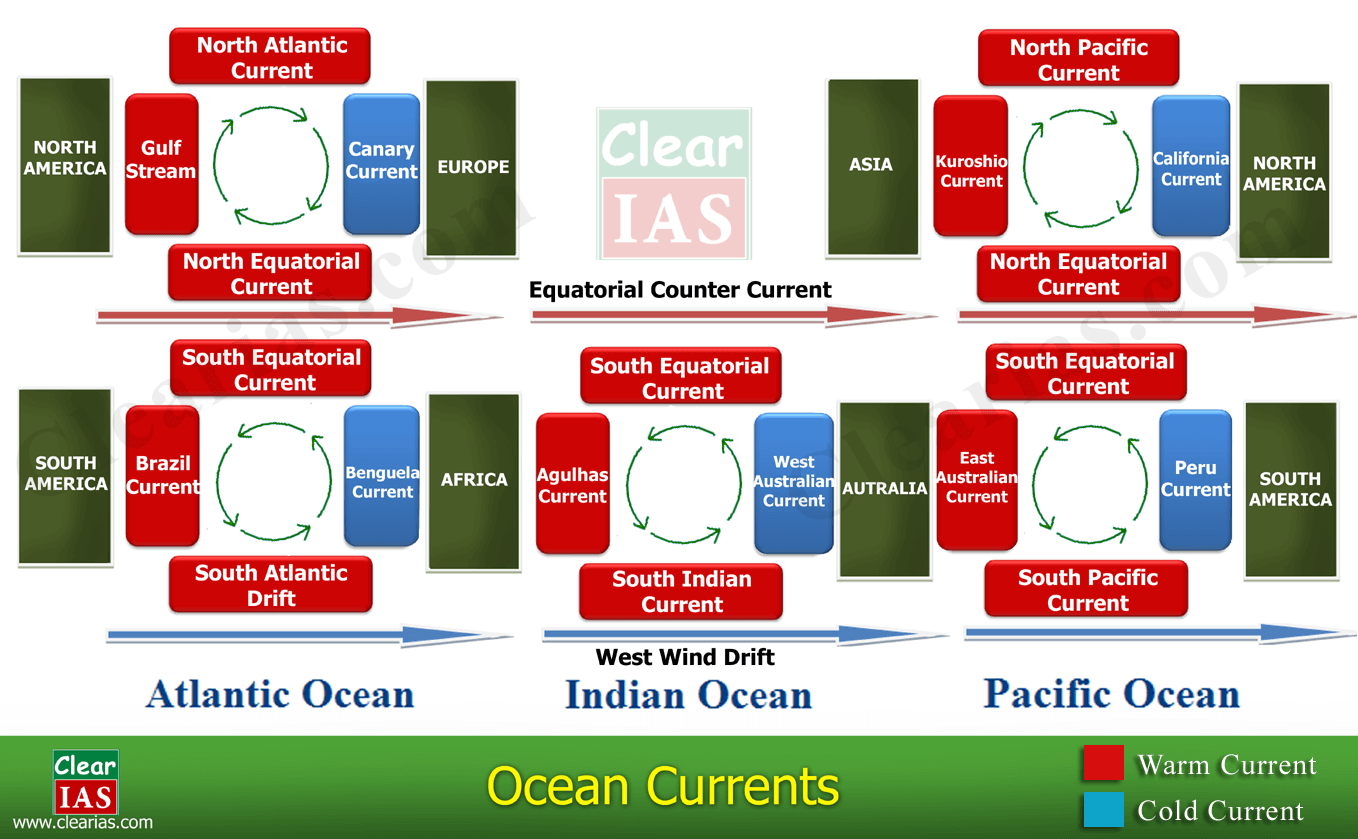
What are the points to remember?
- There are gyres in each of the oceans – The Pacific, Atlantic and Indian ocean. (Any large system of rotating ocean current, particularly those involved with large wind movements is called a Gyre.).
- Current direction: In general, currents in the northern hemisphere travel in the clockwise direction in a gyre, while currents in the southern hemisphere travel in the anti-clockwise direction ( the only exception is the current direction in the Indian ocean, which changes seasonally.)
- The ocean current movement in the north-Atlantic gyre, as well as north-Pacific gyre, is clockwise, while the gyres in the Southern hemisphere are anti-clockwise.
- Current temperature: In general, currents in the western part of every continent are cold (the exceptions are mentioned in the article on movements of the ocean water).
- Currents coming from the polar region are generally cold.
- Currents near to equator are generally warm.
- There is a counter-equatorial current, which moves from west to east (warm).
- The west-wind drift moves from west to east (cold)
Now, that’s the only quick note you need to learn the flow pattern of ocean currents. With the above points, you can find the nature of almost all currents. Let’s analyse the major ocean currents.
-
North Equatorial Current
- It is a significant Pacific and Atlantic Ocean current that flows from east to west.
- They flow in between 100 north and 200 north latitudes.
- Despite its name, the North Equatorial Current is not connected to the equator.
- In both oceans, it is separated from the equatorial circulation by the equatorial countercurrent, which flows eastward.
-
South Equatorial Current
- It is a significant ocean current in the Pacific, Atlantic and the Indian Ocean that flows from east to west.
- They flow in between the equator and about 200 south.
- In the Pacific and Atlantic Oceans, it extends across the equator to about 50 north.
-
Equatorial Counter Current
- It is an eastward flowing current found in the Atlantic, Indian and Pacific Oceans.
- It is found in between the North Equatorial and South Equatorial Currents at about 3-100 northern latitudes.
- This counter-current replaces the water removed from the eastern side of the ocean by the North Equatorial and South Equatorial Currents.
- In the Indian Ocean, the current tends to reverse hemispheres seasonally due to the impact of reversing Asian monsoons.
-
Antarctic Circumpolar Current or West Wind Drift
- It is an ocean current that flows from west to east around Antarctica.
- The current is circumpolar due to the lack of any landmass connecting with Antarctica and thus keeps warm ocean waters away from Antarctica.
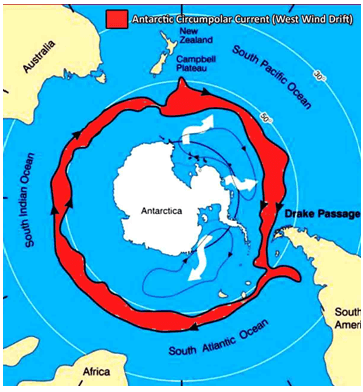
- The Antarctic Convergence is associated with this current. It is the region where the cold Antarctic waters meet the water of the Sub-Antarctic, creating a zone of upwelling (a zone of very high marine productivity).
Gyres of Ocean Currents in each of the major Oceans
The major loops are seen in the Pacific Ocean, Atlantic Ocean and the Indian Ocean in both the hemispheres. Each of the currents follows more or less a definite pattern. But the currents in the Indian Ocean (Northern Hemisphere) change the flow direction between summer and winter.
Currents of the Atlantic Ocean
- To the north and south of the equator, there are two westward-moving currents, i.e., the North and the South Equatorial Currents.
- Between these two, there is the counter-equatorial current which moves from west to east.
Atlantic Ocean: Northern Hemisphere
- The South Equatorial Current bifurcates into two branches near the Cape De Sao Roque in Brazil and its northern branch joins the North Equatorial Current.
- A part of this combined current enters the Caribbean Sea and the Gulf of Mexico, while the remaining current passes along the eastern side of the West Indies as the Antilles Current.
- The part of the current which enters the Gulf of Mexico comes out from the Florida Strait and joins the Antilles Current.
- This combined current moves along the south-eastern coast of the U.S.A. and is known as the Florida Current up to Cape Hatteras.
- Beyond Cape Hatteras, it is known as the Gulf Stream.
- The Gulf Stream starts when it exits the Florida Strait and follows North America northward to Newfoundland.
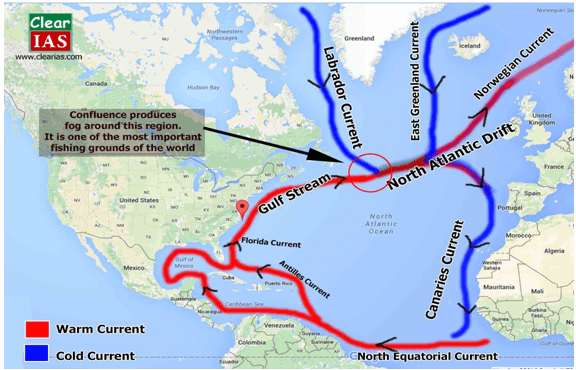
- A cold current from the Arctic Ocean called Labrador Current, which flows along the eastern coast of Canada, meets the warm Gulf Stream near the northeast corner of the U.S.A.
- The confluence of these two currents, one cold and the other warm, produce fog around the region and makes it the most important fishing ground in the world.
- The Gulf Stream then deflected eastward under the combined influence of the westerlies and the rotation of the earth.
- It then crosses the Atlantic Ocean as the warm North Atlantic Drift.
- In this journey, another cold current from the Arctic called the East Greenland Current joins with the North Atlantic Drift.
- The North Atlantic Drift bifurcates into two branches on reaching the eastern part of the ocean.
- The northern branch continues as North Atlantic Drift; reaches the British Isles from where it flows along the coast of Norway as the warm Norwegian Current and enters the Arctic Ocean.
- The southern branch flows between Spain and Azores Island as the cold Canaries Current.
- The Canaries Current finally joins the North Equatorial Current and completes the circuit.
Atlantic Ocean: Southern Hemisphere
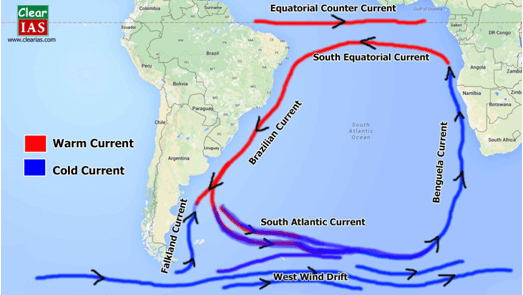
- The South Equatorial Current turns south and flows along the eastern coast of South America as Brazil Current.
- At about 350 south latitude, due to the influence of westerlies and the rotation of the earth, the current moves eastward.
- A cold current called the Falkland Current which flows along the south-eastern coast of South America from south to north joins with the current at this time.
- The Brazil Current moves eastward and crosses the Atlantic Ocean as South Atlantic Current.
- A part of the west wind drift or the Antarctic Circumpolar Current merges with the South Atlantic Current while crossing the Atlantic.
- Near the Cape of Good Hope, the South Atlantic Current is diverted northward as the Cold Benguela Current.
- Benguela Current finally joins with the South Equatorial Current and completes the circuit.
Also read: Bottom topography of Atlantic Ocean
Currents of the Pacific Ocean
Pacific Ocean: Northern Hemisphere
- The North Equatorial Current turns northward and flows along the Philippines Islands, Taiwan, and Japan to form the warm Kuro Shio or Kuro Siwo current.
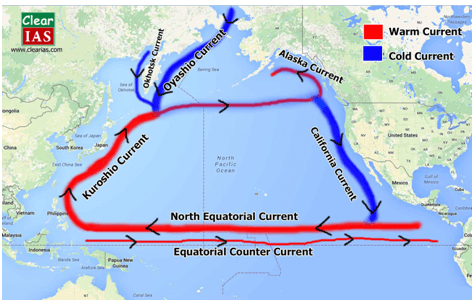
- Later, a cold current called Oya Shio or Oya Siwo which flows along the eastern coast of the Kamchatka Peninsula merges with the Kuro Shio Current (Okhotsk Current is a cold current that merges with the Oya Shio before its confluence with Kuro Shio).
- From the southeast coast of Japan, the Kuro Shio current comes under the influence of westerlies and flow right across the ocean as the North Pacific Current.
- After reaching the west coast of North America, it bifurcates into two branches: the northern branch flows anti-clockwise along the coast of Alaska as warm Alaska Current and the southern branch moves southward along the coast of California as the cold California Current.
- California Current eventually joins with the North Equatorial Current and completes the circuit.
Pacific Ocean: Southern Hemisphere
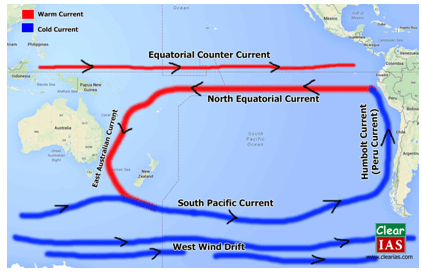
- In the South Pacific Ocean, the South Equatorial Current flows towards the west and turns southward as the East Australian Current.
- From Tasmania, it flows as the cold South Pacific Current from west to east and crosses the Pacific Ocean along with the West Wind Drift.
- On reaching the south-western coast of South America, it turns northward and flows as the cold Peru Current or Humbolt Current.
- The cold waters of the Peru Current are partially responsible for making the coast of northern Chile and western Peru with very scanty rainfall.
- Peru Current eventually joins with the South Equatorial Current and completes the circuit.
Currents of the Indian Ocean
- The pattern of circulation of ocean currents in the Indian Ocean differs from the general pattern of circulation in the Atlantic and the Pacific Oceans.
- This is because the Indian Ocean is blocked by the continental masses in the north.
- The general pattern of circulation in the southern hemisphere of the Indian Ocean is anti-clockwise as that of the other oceans.
- In the northern hemisphere, there is a clear reversal of currents in the winter and summer seasons, which are completely under the influence of the seasonal changes of monsoon winds.
Indian Ocean: Northern Hemisphere during winter
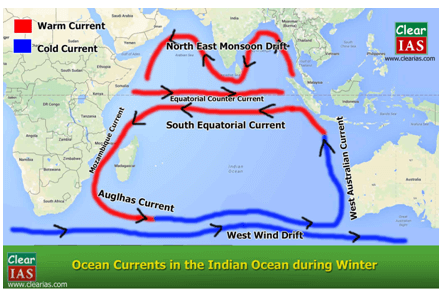
- During winter, Sri Lanka divides the currents of the Arabian Sea from those of the Bay of Bengal.
- The North-East Monsoon Drift flows westward just south of Sri Lanka with a countercurrent flow between it and the South Equatorial Current.
- During the winter season, in the northern section, the Bay of Bengal and the Arabian Sea are under the influence of North East Monsoon Winds.
- These North East Monsoon winds drive the waters of the Bay of Bengal and the Arabian Sea westward to circulate in an anti-clockwise direction.
Indian Ocean: Northern Hemisphere during summer

- In summer, the northern part comes under the influence of the South West Monsoon.
- It results in an easterly movement of water in the Bay of Bengal and the Arabian Sea in a clockwise direction.
- This current is called the South West Monsoon Drift.
- In the Indian Ocean, the summer currents are more regular than those of the winter.
Indian Ocean: Southern Hemisphere
- In the southern part, the South Equatorial Current which flows from east to west is strengthened by its corresponding current of the Pacific Ocean.
- It then turns southward along the coast of Mozambique in Africa.
- A part of this current moving in between the African mainland and Mozambique is called the warm Mozambique Current.
- After the confluence of these two parts, the current is called Agulhas Current.
- Agulhas Current merges with the West Wind Drift when it crosses the Indian Ocean.
- A branch of this merged current flows along the western coast of Australia as the cold West Australian Current.
- It later joins with the South Equatorial Current to complete the circuit.
Also read: Indian Ocean Geoid Low
Summary
As mentioned above, the quick way to remember ocean currents is to remember the gyres.
Currents in the western part of every continent are cold.
Currents coming from the polar region are generally cold.
Currents near to equator are generally warm.
Article by: Jijo Sudarsan









Excellent.. I have been trying to find an easier way to study all these currents since a long time back..Thank u so much for this.. U have put this in such a way that it is very simple to understand and memorize.. Thanks again
It’s Simple and easy to remember thanks
Holly molly, it can’t get easier than this…hats off clear ias..you nailed it ?
very simple to understand..thanks for your efforts sir..
Amazing and awesome!
Hats off Clear ias team for your efforts in teaching students free of cost as simple as possible!
very very useful article…
Awesome. ..my goodness that I’m here to read all this output of such a great hard work by you sir.
Thank is not even enough to say
Keep posting sir
very nice, hearty thanks to you
it is very useful for us to prepare without any coaching
What more an ias aspirant can expect ??? Very nice !! U naiked it @ clearias .
Is it available in hindi form
Great work…simple mind map of ocean currents.
very useful
Thank you for providing precious study materials. Really it is very helpful for everybody. Thanks a lot for the entire Clear IAS team.
Thanks very much for your help Clearias
I was searching for too long for this kind of method on YouTube. Here I got this.
Thanks.
Thanks…..The way u teach is very nice…..Easy to understand and interesting also
Thank you sir for inducing confidence on ocean current topics
thank you sir
you are given valuable information for ocean currents.
the diagrammatic way and clear explanation as well as indications superb sir thank you very much sir
thank u so much sir it is too helpful n easy way to remember the currents very helpful information thanks
There’s no counter equatorial current in Indian ocean during summer
Why current of the atlantic is studied first is there any reason
very great i appreciate it.
Some corrections for the Atlantic:
1. The Gulf Stream starts when it exits the Florida Strait and follows North America northward to Newfoundland.
2. It’s Florida “Strait”, not “Straight.”
3. It’s Cape Hatteras, not Cape of Hatteras.
Thank you for pointing out the corrections. Updated.
Thank you Clear IAS.
nice
thank u so much for very good explanation
Nice Clearias. Easy to remember. Thank you for nice explanation.
Thank you for the comments.
Good presentation